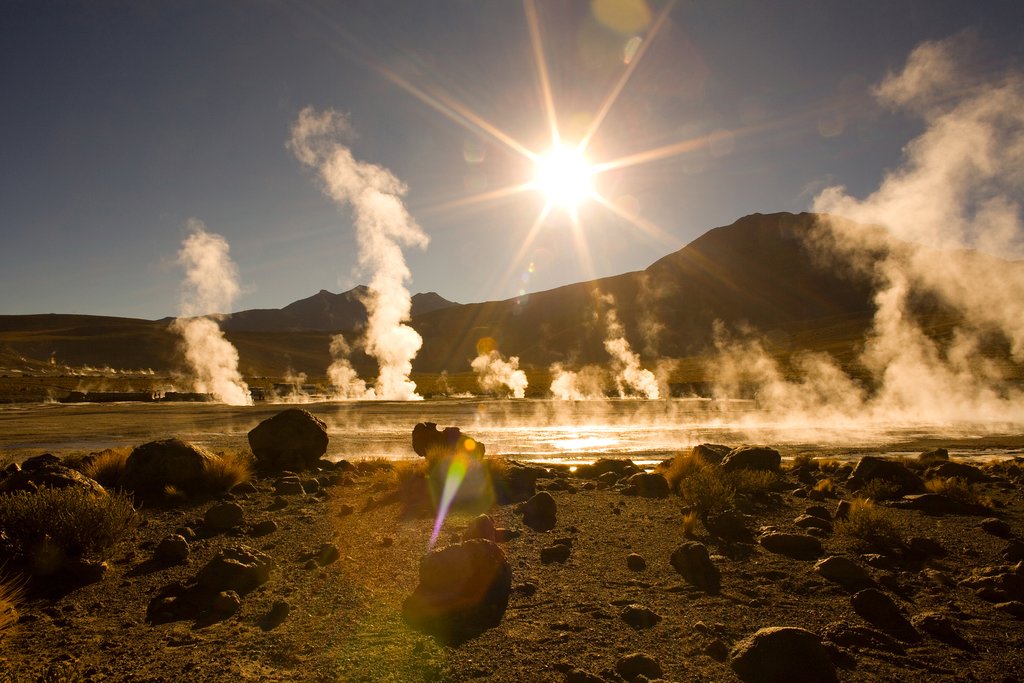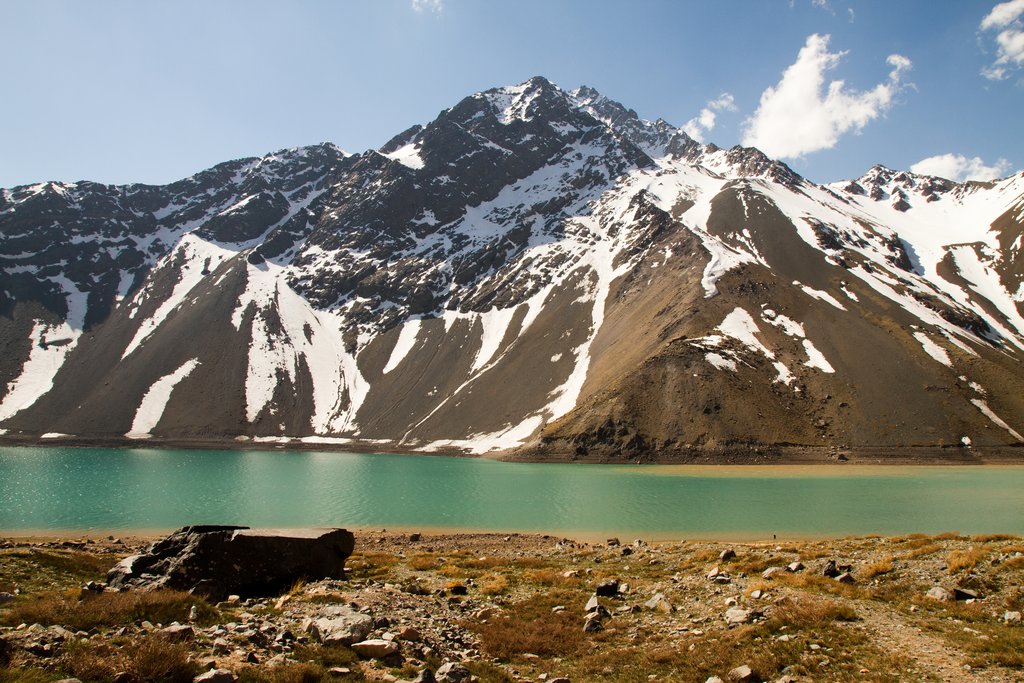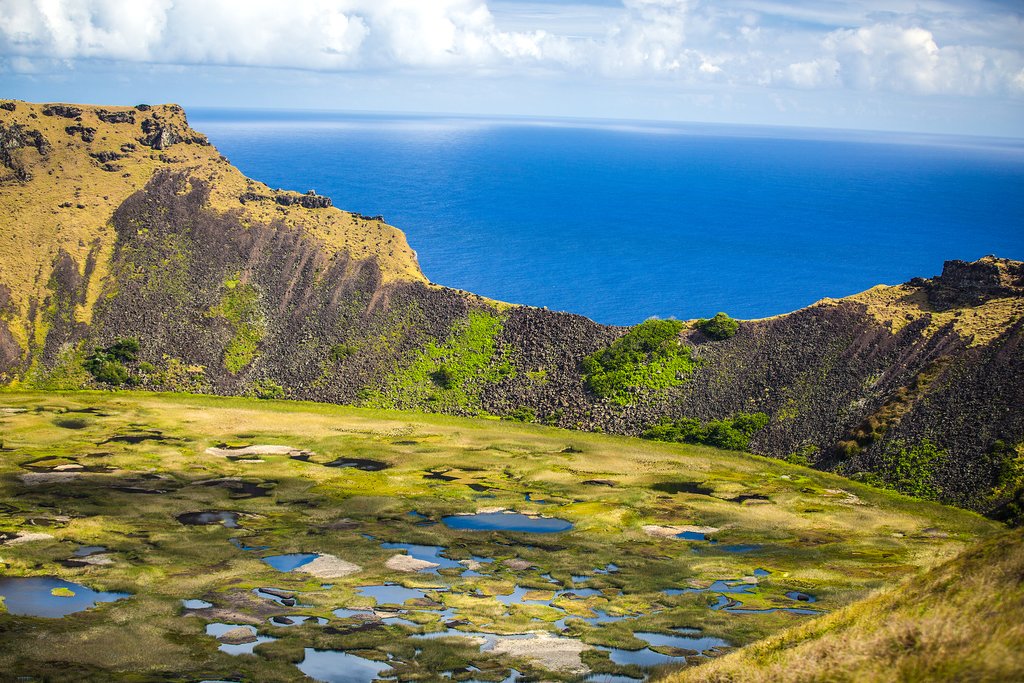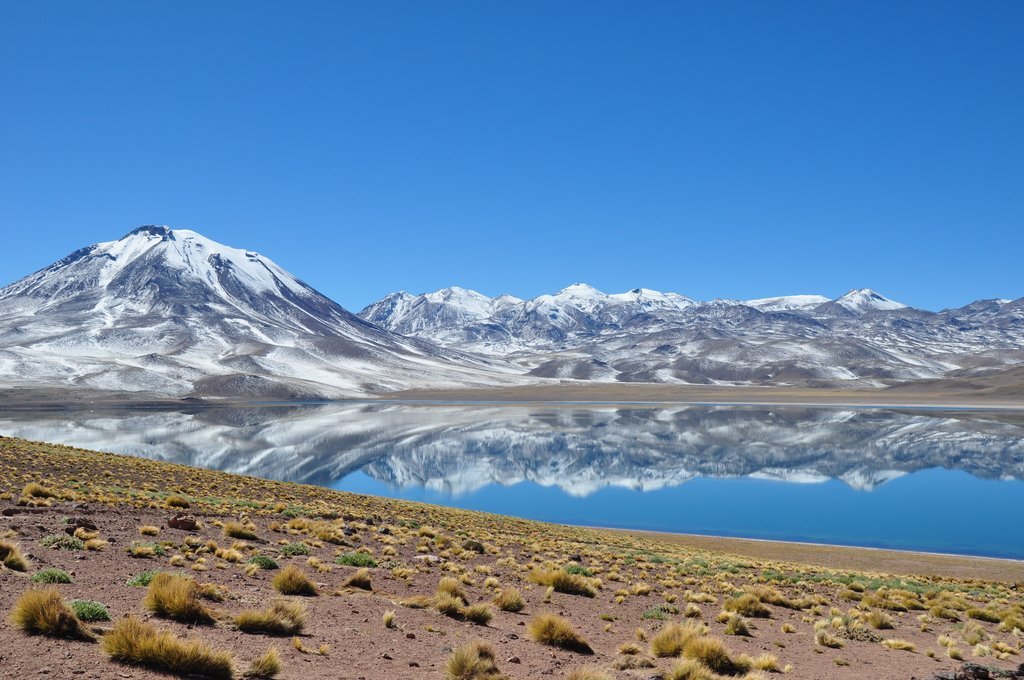Highlights
- Discover geysers, lagoons, salt flats, and lunar landscapes in the Atacama Desert
- Tour Santiago and embark on day trips to colorful Viña del Mar and Valparaíso
- Explore the gorges, peaks, and rivers of the Maipo Valley
- Visit Easter Island and learn the secrets of the moai, the ancient stone idols
Brief Itinerary
| Day | Highlights | Overnight |
|---|---|---|
| Day 1 | Arrive in Santiago, Explore | Santiago |
| Day 2 | Fly to San Pedro de Atacama & Stargazing Tour | San Pedro de Atacama |
| Day 3 | Atacama Desert, Lagoons & Salt Flats | San Pedro de Atacama |
| Day 4 | Tour El Tatio Geysers & Return to Santiago | Santiago |
| Day 5 | Santiago City Tour | Santiago |
| Day 6 | Viña del Mar & Valparaíso Excursion | Santiago |
| Day 7 | Maipo Valley Full-Day Tour | Santiago |
| Day 8 | Fly to Easter Island, Optional Activities | Easter Island |
| Day 9 | Rapa Nui Full-Day Tour | Easter Island |
| Day 10 | Orongo & Ahu Akivi Tour | Easter Island |
| Day 11 | Free Day on Easter Island | Easter Island |
| Day 12 | Depart Santiago |
Detailed Itinerary
Day 1: Arrive in Santiago, Explore

Welcome to Chile! Upon arrival at Santiago International Airport, a driver will meet you and transfer you to your hotel. The rest of the day is yours to explore the city at your leisure.
Suggested activities include:
- Hike to the top of Cerro San Cristóbal, where you can survey the area from a high vantage point. Pathways lead 2,788 feet (849 m) up this central hill to a series of lookouts that offer wraparound views of Santiago. If you're not the hiking type, don't worry—catch a scenic gondola instead.
- Stroll the cobblestone streets of Barrio Bellavista. On the north side of Santiago, you'll find this trendy enclave with a fashionable and bohemian vibe. Stroll past colorful houses adorned with graffiti art and choose between an eclectic array of eateries and bars—great for people-watching.
- A visit to the Plaza de Armas, located in Santiago's historic center. There's a lot of history within the four corners of this expansive stone plaza, as it was founded all the way back in 1541. Nearby sits the impressive Catedral Metropolitana, a neoclassical church circa 1748, with towering twin bell towers dominating the north side of the plaza.
- Snap photos in front of the Palacio de la Moneda. Chile's opulent presidential palace (La Moneda) is a short stroll from the Plaza de Armas. It was here in 1973 that Chile's armed forces, backed by the US government, overthrew President Salvador Allende, kicking off a brutal right-wing military dictatorship that would last for 17 years. Visitors are welcome.
For dinner, be sure to enjoy a culinary adventure in the city. In recent years, Santiago has emerged as a global foodie destination. Chilean chefs are reinventing traditional dishes, like empanadas, cazuelas (stews), and seafood with ingredients harvested all the way from the northern deserts and southern Patagonian regions. You can find great restaurants and wine bars not only in the Bellavista neighborhood but also in the revitalized historic barrios of Yungay and Italia.
Day 2: Fly to San Pedro de Atacama & Stargazing Tour

This morning, transfer from your hotel in Santiago to the airport for your flight to the city of Calama, located in the far north of the country. Upon arrival, another driver will meet you for the 1.5-hour drive to the desert outpost of San Pedro de Atacama. This is the embarkation point for all excursions and adventures into the Atacama Desert.
During the journey between these two places, witness some of the most evocative and ancient landscapes anywhere in the world. This high-altitude desert abounds with seemingly endless salt flats, painted hills that change color depending on the light, towering Andean peaks, and the volcanic Domeyko Cordillera, where flaming-red mountains create the base of Moon Valley. Once in San Pedro, check into your hotel and relax for the remainder of the afternoon until it's time for your first excursion. At the scheduled time, a driver will meet you for the 15-minute drive outside of town and into the desert.
First, sit for a 20-minute presentation to learn some basic astronomy concepts. Then, head outside to the open Altiplano and learn how to identify various constellations. This desert plateau is an ideal spot for stargazing due to its high altitude, at about 7,900 feet (2,407 m). Even seen by the naked eye, the stars here are more vivid than anything you've likely experienced before. The outing culminates with views of the sky through high-powered telescopes and binoculars. Spot a wide array of celestial objects, including planets, binary stars, spherical clusters, and others. Even better, do your stargazing accompanied by a glass of good Chilean wine. At the end of this astronomical outing, return to San Pedro de Atacama.
Day 3: Atacama Desert, Lagoons & Salt Flats

Today, embark on a full-day excursion into the Atacama Desert. After breakfast, a driver will pick you up at the hotel to head to the first destination: Laguna Chaxa. Located 31 miles from San Pedro, this desert oasis sits in the middle of the Atacama Salar salt flats. Also, here is Los Flamencos National Reserve. Even from afar, you can spot the Chilean flamingoes that call this reserve home—their pink feathers shining brightly against the contrasting blue of the shallow water.
At lunchtime, the tour will stop in Socaire, an agricultural village famous for its simple adobe homes, rustic chapel, and slow pace of life. After the meal, the tour will continue toward the Altiplano (high plateau) lagoons of Miscanti and Miñiques, located at 13,779 feet (4,200 m) in elevation. You might feel a bit lightheaded, so try not to exert yourself too much and drink plenty of water. Enjoy the panoramic views of an Altiplano desert surrounded by towering volcanoes and busy with wildlife, like flamingoes, foxes, and vicunas.
The last stop on the tour is a visit to the town of Toconao, an oasis with a climate ideal for the cultivation of native fruits and vegetables. Stroll the streets, shop for handicrafts, and admire local homes cobbled together from volcanic rocks. Visit the whitewashed church with its famous three-story bell tower. The church dates back to 1750 and has been declared a national monument. At around 6 pm, return to your hotel to enjoy the rest of the evening in town.
Day 4: Tour El Tatio Geysers & Return to Santiago

Today calls for an early start. Depart the hotel at 4:30 am for the 1.5-hour trip to the Tatio Geysers. Getting a jump on the day will reward you with an unforgettable sunrise over the Atacama Desert—the best time to visit Tatio. The contrast between the cold outside temperatures and the boiling water of the geothermal field beneath the earth's surface causes the pillars of steam here to rise as high as 30 feet (9 m).
At an altitude of 14,173 feet (4,319 m), the Tatio Geysers are the highest in the world. Take your time admiring these otherworldly landscapes, snap plenty of photos, and at the appropriate hour, breakfast will be served on-site. In addition, you can take an optional, relaxing soak in a natural geothermal pool—Mother Nature's Jacuzzi.
On the return drive to San Pedro, stop at Machuca, a small village on the Altiplano whose residents have bred llamas and harvested Yareta (moss-like evergreen plants that can survive for thousands of years) for generations. It's a small but welcoming town, comprised of only about 20 homes and a simple chapel. Some locals sell crafts you can peruse, and you can admire the llamas in the area, as well as the flamingoes that reside in nearby marshlands. In the afternoon, make the transfer from San Pedro to Calama and catch a domestic flight back to Santiago.
Chat with a local specialist who can help organize your trip.
Day 5: Santiago City Tour

Like any great city, Santiago's cultural pulse is found in its people, marketplaces, and cuisine. Today, head out on a guided city tour. Depending on your preference, this will either be a full-day or half-day tour with an English-speaking guide.
Highlights of the tour include:
- Wandering the aisles of Santiago's labyrinthine Mercado Central and Mercado La Vega. These markets are the beating heart of the city, overflowing with vendors and residents eager to get their hands on the day's fresh produce.
- Visit the Catedral Metropolitana, a neoclassical church dating to 1748, whose win bell towers dominate the north side of the plaza.
- Heading to Costanera Center, an epic skyscraper encased in glass. For one of the best and certainly highest views in Latin America, go to the sky viewpoint. At nearly 1,000 feet (304 m) high, the top offers full panoramic views of the city below, as well as the surrounding Andes.
- Visiting Cerro Santa Lucia, a small, manicured park in the center of Santiago. As you stroll up the hill, make sure to stop and see Fuente Neptuno and Castillo Hidalgo, two impressive structures located within the grounds.
- Ascending to the top of Cerro San Cristóbal via hike or cable car—if you haven't done so already. Enjoy the 360 degrees views, and take plenty of photos, as these are the most incredible views in Santiago.
Day 6: Viña del Mar & Valparaíso Excursion

Today, leave the capital on an excursion to central Chile's Pacific Coast. Visit two neighboring cities: Viña del Mar and Valparaíso. First, arrive in Viña del Mar, an upscale coastal resort city teeming with shopping complexes, commercial high-rises, boutiques, and well-manicured gardens. The city's modern image is the result of reconstruction efforts following the numerous earthquakes the Chilean coast has endured over the years. However, there are still 20th-century landmarks, like the Germanic Wulff Castle and the Venetian-Gothic Vergara Palace, the former home of the founder of Viña del Mar. The city is the perfect place to enjoy a seaside lunch at one of the many upscale restaurants on the shore.
Next, visit the port city of Valparaíso, located adjacent to Viña del Mar. This colorful metropolis is the artistic and bohemian soul of the country. It's filled with street art, music, and poetry. Moreover, it's a throwback to the turn of the 20th century, when electric trolleys coasted along the waterfront, and lurching funicular elevators carried passengers to the highest points in the city.
Start exploring Valparaíso by visiting the old plazas of Sotomayor and Aníbal Pinto. Then, ride the Reina Victoria funicular and ascend to the top. From here, wander the hilly neighborhoods of Cerro Alegre, Cerro Concepción, and Cerro Florida. On the last hill, find La Sebastiana, a museum once the home of the famed Chilean poet Pablo Neruda.
No matter where you go, you can always find sweeping views looking out over the colorful houses to the Pacific Coast and the blanket of blue water running out to the horizon. Following the exploration, head to the minivan to transfer back to Santiago and return to your hotel.
Day 7: Maipo Valley Full Day Tour

Today, experience more of Chile's famous natural beauty with a visit to Cajón del Maipu. After breakfast, embark on a 45-minute road trip southeast of Santiago to this popular gorge. First, arrive in the fertile San José de Maipo region, with its hills and vineyards. Then, it's an ascent into the mountains, where the landscapes become even more dramatic as massifs and snowcapped peaks dominate the skyline. Take in the sparkling rivers and streams that wind through this paradise.
After reaching 9,843 feet (3,000 m) above sea level, exit the vehicle at the shores of the Embalse de Yeso, a reservoir nestled in the Andes with a glassy surface that shines bright turquoise. Enjoy the landscape and snap photos of the panoramic vistas. Walk around the shore as your expert guide offers insight into the geology of the area, as well as the history of the reservoir, a result of damming the Yeso River back in 1964.
For lunch, sit near the water and enjoy a picnic with a selection of top Chilean wines. Afterward, return to San José de Maipo and stop in at a local restaurant to try a traditional snack—the Chilean empanada. Transfer back to your hotel in Santiago and enjoy the evening on your own.
Day 8: Fly to Easter Island, Optional Activities

After breakfast, make your way to the most remote inhabited land in the world: Rapa Nui, or Easter Island, as it's commonly known. The trip involves a transfer from your hotel to the airport to catch a three-hour flight to the island. After transferring to your hotel and checking in, spend the remainder of the day exploring at your leisure.
There are around 600 stone figures, or moai, on this island—some of which reach 32 feet (10m) in height. Many of them stand on the stone ahu (ceremonial pillars) that dot the island's green hillsides. For a bit of history, these were fashioned out of volcanic rock by the first Polynesian settlers after they arrived in 800 CE. The figures themselves represent deceased leaders of the five tribes that once inhabited the island and supposedly offered spiritual protection. Around the 16th century, the islanders exceeded their natural resources and—as a result of famine and war—tore down many idols, believing they outlasted their usefulness.
By the 19th century, Europeans, smallpox, and slavery arrived, annihilating some of the population while more emigrated to Tahiti to work on plantations. Eventually, the population rebounded, and Rapa Nui was annexed to Chile in 1888. Locals today are governed under a council of Indigenous chiefs.
Suggested activities on the island:
- Explore Hanga Roa. This is the main town on Easter Island, with 3,000 residents, or roughly 87 percent of the island's inhabitants. Hanga Roa has a small-town coastal vibe with restaurants serving ceviche, empanadas stuffed with fresh tuna, po'e (a pumpkin and plantain cake), and taro ice cream.
- Visit the Museo Antropológico Sebastián Englert. For an introduction to island life, come to this anthropological museum and view exhibits celebrating the Indigenous patrimony, such as ancient tools, totems, sculptures, and more.
- Take a hike outside of town to Ahu Tahai. Here, there are some moai, as well as caves nearby. It also makes a great sunset-viewing spot for your first night on the island.
Day 9: Rapa Nui Full-Day Tour

After breakfast, embark on a full-day tour of the island. It's an informative journey that will shed light on Rapa Nui's famous archaeological sites. Start at Ahu Te Pito Kura, a unique rock structure featuring a central stone that, according to a legend, was brought over by a king of the first tribes and supposedly still emits spiritual power.
Then, it's off to Rano Raraku, an impressive volcanic crater. Seek out many moai along the base. Next, enjoy a delicious snack at Ahu Tongariki, the biggest ceremonial platform on the island. Here, there are 15 moai displayed in a row. After touring the site, visit another ceremonial platform called Ahu Akahang and finish off the day at the beautiful, white-sand beach of Anakena.
Day 10: Orongo & Ahu Akivi Tour

Today is another exciting day of exploring Easter Island. The itinerary includes two half-day tours to Orongo and Ahu Akivi. After breakfast, travel a few minutes to the southwest corner of Rapa Nui and the remains of the village of Orongo. Located on the rim of an inactive volcano called Rano Kau, this area enjoys a special place in the island's history, as it was the principal site of what's known as the "Birdman" era. The cult of the Birdman took root in Rapa Nui in the 16th century after locals gave up on the moai due to war and famine.
The cult of the Birdman was also a contest. To appease their deity, called Meke-Meke, islanders would hold an annual competition to see who would be crowned the next chief. The contest involved a group of men swimming to two nearby islands and waiting until terns (seabirds) laid their first eggs of the season. Whoever returned with the first egg became chief for a year, also dubbed the Birdman. Orongo was the ceremonial village in which he was crowned. You'll visit not only the village and the volcano but also a cave by the sea known as Ana Kai Tangata. Inside this cave, view petroglyphs fashioned by the ancient inhabitants of the island. This excursion ends in the early afternoon and concludes the first tour of the day.
The second tour involves a trip about 1 mile (1.6 km) inland to visit Ahu Akivi. This place is home to seven moai, but in ancient times, it also doubled as a celestial observatory. In other words, this is where islanders came to stargaze. An interesting feature is that the seven moai all face sunset during the spring equinox, and their backs are to the sunrise during autumn. While here, take a short hike to two other archaeological sites: the cave of Ana Te Pahu, the largest cavern on Rapa Nui, and the Puna Pau volcano. Following the tours, the evening is at your leisure.
Day 11: Free Day on Easter Island

Today is a free day to enjoy the island any way you'd like. If you're feeling active, there are opportunities for diving, snorkeling, and surfing. On land, explore the island's beauty by bike, foot, or horseback. For some relaxation, spend a day at the beach. Revisit Anakena. It receives few visitors—especially in the morning, since most tours arrive in the afternoon. If you're lucky, you may enjoy a small bit of paradise—all to yourself.
In addition to its restored monuments, Ahu Ature Huki and Nau Nau, the beach is known for its warm water and pristine white sand—an inviting place to sunbathe and swim year-round. On the outskirts of the beach, there are two restaurants where you can grab a bite to eat. To spend your last day here, relaxing with the spiritual statues nearby, is a special experience.
Day 12: Depart Santiago

Today marks your last day on the island. Depending on your flight schedule, you should have some free time to explore Rapa Nui a bit more before transferring to the airport. Then, hop on a flight back to Santiago and catch your connecting flight home.
More Great Chile Itineraries
Looking for more inspiration for your trip to Chile? Check out these other Chile itineraries, explore different ways to spend 12 days in Chile, or discover the best time to visit Chile.


